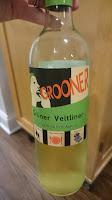I'm always a sucker for a bargain, and there was an Amazon Local deal for a 6-course tasting menu at Le Cirque. Now I've heard of
Le Cirque - its one of the top French restaurants in NYC, so I was intrigued. Long story short, I bought the deal, made my husband put on a suit, and had a wonderfully decadent meal.
We started out with the complimentary
amuse-bouche, which was a tiny dollop of strangely delicious pea puree.
Then it was time to begin our delectable journey. We figured the sommelier's wine pairings were the way to go. He obviously knows a whole lot more than us; plus we're fancy like that. ;)
First Course:
Choice of Foie Gras or Sashimi Halibut with Roasted Red Peppers; served with
IVY Blanc de Blancs, a lovely, dry sparking wine.
Second Course:
Lobster Risotto served with
Vievite Cuvee Extraordinaire. This was the palest rose that I have ever seen, and it was dry and refreshing and a wonderful pairing for the richness of the lobster.
Third Course:
White Asparagus, Scallop, Sweatbreads, and Quail Egg with an Anchovy Sauce; served with
Fogdog Chardonnay. I am not a huge fan of Chardonnay, and this was a seriously oaky chard. I'm not really into anchovies either, and the maitre d' had just poured the sauce all over everything. BUT this ended up being my favorite course. The sauce was light and tangy and not anchovy-y, AND it totally worked with the chardonnay.
Fourth Course:
Scottish Salmon and Sage-Infused Potatoes with
Barolo Le Ginestre. This wine was extremely aromatic with floral and baking scents, but then it was very light bodied and more earthy on the taste. Also, the potatoes were amazing!
Fifth Course:
Choice of Chicken or Lamb; served with
Hall Cabernet Sauvignon. Both the chicken and the lamb were succulent and were complimented by the Cabernet. To finish off this course, we were given little push-pop things ( I guess it was palate cleanser or something?). We didn't understand what they said about them, and the flavor was not impressive or identifiable, but they looked neat, even if somewhat phallic.
Sixth Course:
For dessert, I kept it simple with ice cream: salted caramel and raspberry. My husband ordered the chocolate stove cake, which much to our surprise came inside of a miniature chocolate stove! These were served with
Braida Brachetto D'Acqui, which was very nice, but a little bit too sweet for me.
It was definitely a splurge, but it was a delicious way to spend our money and evening.





























